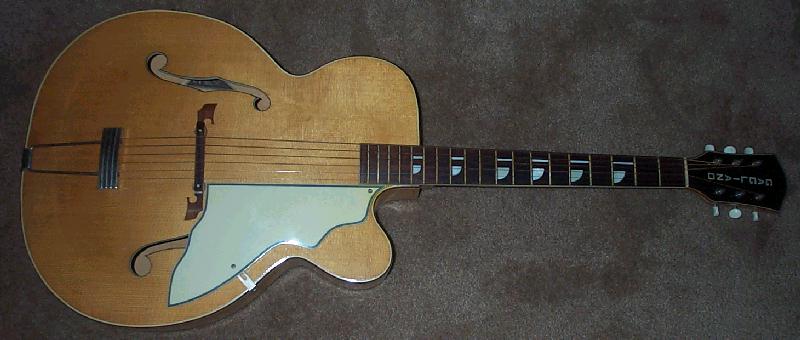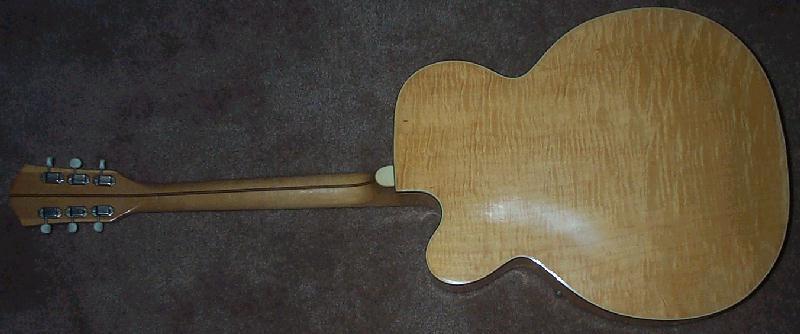
Copyright 1997, 20th Century Guitar Magazine.
The Kay Company of Chicago, Illinois made guitars for jobbers under various names including Silvertone and Oahu. A lesser known jobber moniker was the Gagliano brand. The Gagliano family was well known for making fine violins and mandolins in Italy during the 18th century. Alessandro Gagliano (b.1660; d.1725), who was reputedly an apprentice of Stradivari's, was the founder of the Gagliano dynasty of violin makers. His son, Gennaro (b. 1700; d. circa 1770), was also a contemporary of Stradivari (d. 1737) and worked in Naples. For those readers who are interested in genealogy, Alessandro’s other son was Ferdinand Gagliano.
The instruments made by the Gagliano’s are highly regarded and fetch hundreds of thousands of dollars. Richard Tognetti, Director of the Australian Chamber Orchestra performs on a 1724 Gagliano violin using raw gut on the two middle strings. The Queen Mother of Spain gave Pablo Casales, perhaps the greatest cellist of this century, a Gagliano cello as a gift of appreciation.
How the Gagliano name found its way onto American made guitars is unknown to me. It’s entirely possible that the jobber who ordered Gagliano branded guitars from Kay was not related to the violin makers. In fact, they may not have been Gagliano’s at all. Wouldn’t it be a goof if the jobber’s name was Ira Rubenstein? Either way, the first Gagliano guitars made by Kay were introduced in the late 1930s and appeared in CMI catalogs of that period. Of the very few Gagliano instruments that I’ve seen (all six of them), it appears that the bulk of the production took place during Kay’s heyday in the 1950s.

The Gagliano archtop shown here is a circa 1953-56 Model 900 and is based on Kay’s own K-11 model. With a model designation of “900" this is likely the top-of-the-line Gagliano acoustic archtop. If it was any fancier it would compete directly with Kay’s own top-of-the-line K-21. In fact, this guitar is far fancier than mid-line Guilds from the same period which is a little hard to swallow since I like Guilds and consider them well above Kay and nearly on par with Gibson in terms of quality. Unlike Kay guitars, the Gagliano has a large rectangular paper label, visible through the bass F-hole, stuck to the back of the guitar. The label reads: “GAGLIANO” and underneath is “900" and “ -0830,” each stamped separately in black ink.
The serial number (0830) is a suffix added after the model number. Based on this, we may assume that each model had it’s own serialization scheme that was sequential. If so, and assuming that production began with serial number 0001, at least 800 or so of these guitars would have been made. But, this is not likely since 800 represents quite a few a guitars. About 900 G&L Broadcasters were made and these routinely show up on dealer stock lists (just check out the ads in this issue’s Guitar Shopper). So, if there really were 830 Gagliano Model 900s out there, we would have seen many more of them at shows and on dealer lists. Since the serial number is stamped as a separate prefix, it may be possible that serial numbers were applied sequentially regardless of model. In this case, number 0830 represents the 830th Gagliano guitar made. Thus ends the theory and conjecture part of this article.

The Gagliano (and equivalent K-11) uses the “standard” formula for upscale archtop construction, i.e. - a single cutaway, blonde finish, 17 inch body with maple back and sides, and a solid spruce top. The spruce top is pressed, not carved and the actual dimensions of the body are 17 1/8" wide and 3 1/2" deep.
The back and sides are laminated maple with a top veneer of flamed maple. The spruce top has good, tight grain, and the guitar is very light weight for an archtop (5.2 lb). The neck is a 5-piece maple/mahogany affair with bound Brazilian rosewood fingerboard. The headstock is fitted with nickel plated Kluson Deluxe tuning keys. The neck profile is typical of a mid-1950s Kay, i.e. Louisville Slugger, however, the large round neck is somewhat necessary for stability since the Gagliano does not have a truss rod. At least the neck has a narrow nut width of 1 5/8 inches.
Despite the large profile and lack of truss rod, the neck is arrow straight and the action is low and supple with medium (13s) phosphor bronze round wound strings. An interesting side note... the strings that were on this guitar when I purchased it were heavy gauge, bronze, flat wounds. The Model 900 is rather easy to play for an experienced guitarist once initial adjustments are made. A novice player would probably be discouraged rather quickly by such a humongous neck.
This Gagliano, like the high end Kays of the 1950s, is very well made and the level of ornamentation is quite nice and somewhat surprising. It has a double bound (white/tortoise) top, back, and headstock. The headstock is overlaid with a Brazilian rosewood veneer that has gorgeous color and grain. The pearloid Gagliano headstock logo is reminiscent of a high end Martin.
The deluxe fingerboard markers, known as quadrants or shark fins to Kay aficionados, and the double bound (black/white) F-holes add even more elegance to this guitar. The “ordinary” aesthetics of the chrome plated trapeze tail is offset by the fancy Kay rosewood bridge. The “batwing” pickguard shape was taken from the top-of-line Kay K-21. The K-21's guard is made of 3-ply white/black plastic whereas the Gagliano’s guard is made of 1-ply plastic. However, it was given additional ornamentation in the form of a white/black/white bound edge.
Not surprisingly, the Gagliano sounds exceptionally good, and it is definitely on par with the K-11 and K-21 of the same period. It is a very responsive instrument and has excellent tone when strummed lightly or heavily. Balance between bass and treble is quite even and the guitar has reasonably good sustain. It is plausible that the light weight contributes to these attributes in a very positive way.
Unlike, most traditional archtops such as the Epiphone Triumph Regent or Gibson L-7C, the Gagliano does not have the typically strong midrange and cutting power associated with these guitars. The guitar is loud, in fact very loud, but it performs more like a flattop guitar. It has the projection of an archtop with a sound that leans closer to a Gibson J-200 than to the traditional swing band era archtop.
High end Kay and Kay-made jobber archtops are an excellent alternative to pricier mid-line Gibson and Epiphone archtops. Kay K-11 and K-21 guitars can be found for under $1000 (1997 dollars), and generally seems to run around $500 to $750 (1997 dollars) depending on the model.
Epilogue: Although he doesn’t play guitar, I gave this archtop to my father for his birthday since his love of music obviously rubbed off on me. He has an extensive collection of jazz, classical, and opera records and tapes that I used to listen to as a kid. Okay, I’ll admit that I really didn’t like the opera (and I still don’t), but the swing, jump jive, be-bop, cool jazz, and even some of the classical music that I listened to really stuck with me. I’m sure the Gagliano Model 900 will make a nice addition to the decor in Dad’s music room. Plus... I get to play it whenever I go home to visit!!
Special thanks to that infomaniac, Dan Segal M.L.S., for his research assistance.
About the author: Greg Gagliano has no idea if he is related to either
the great violin makers of Italy or the jobbers who ordered Kay guitars with
the Gagliano name.